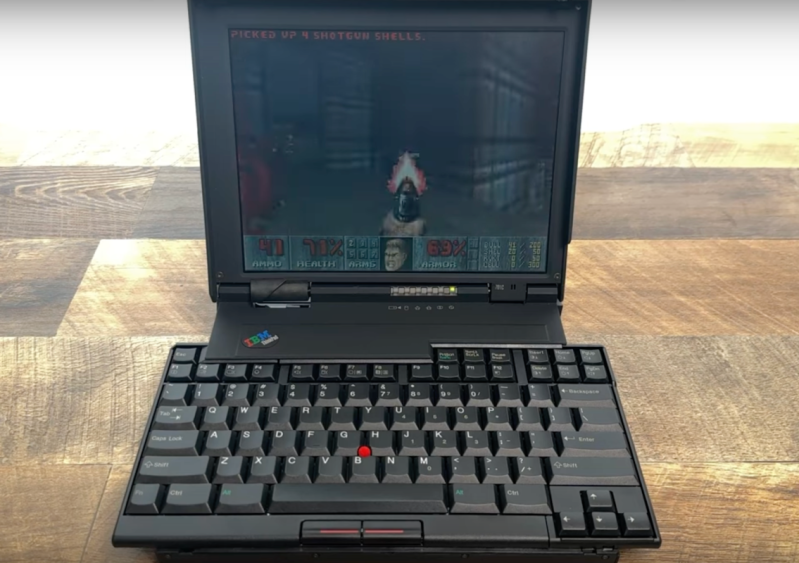The ThinkPad 701 is an iconic laptop series from the mid-90s and is still highly sought after today because of its famous butterfly keybaord. The laptop itself is tiny even by the standards of the time, so in order to fit a full-size keyboard IBM devised a mechanism where the keyboard splits and slides over itself to hide away as the screen is closed. But, like most 30-year-old laptops, the original batteries for these computers are well past their prime. [polymatt] takes us through all of the steps needed in order to recreate a battery from this era down to the last detail.
He starts by disassembling an old battery with extensive damage from the old, leaky batteries. The first part of the recreation is to measure the battery casing so a new one can be modeled and printed. The control boards for the batteries of these computers were not too sophisticated, so [polymatt] is able to use a logic analyzer with a working unit to duplicate its behavior on an ATtiny microcontroller. With that out of the way, a new PCB is created to host the cloned chip and a new battery pack, made out of 9 NiMH cells is put together.
[polymatt] wanted this build to be as authentic as possible, so he even goes as far as replicating the label on the underside of the battery. With everything put together he has a faithful recreation of this decades-old battery for a famous retro laptop. ThinkPads are popular laptops in general, too, due to their fairly high build quality (at least for their enterprise lineups) and comprehensive driver support especially for Linux and other open-source software projects like coreboot and libreboot.
Thanks to [Roman UA] for the tip!















How does the processing power of the new battery controller compare to that of the laptop?
It’s only an ATtiny, so 8 bits at max. 16MHz. The laptop had, at most, a 486 DX4 at 75MHz, so that’s like 20 times faster, probably more because it has a more powerful instruction set (you can’t really compare 8-bit and 32-bit this easily but it’s an estimate).
Imagine using a modern 32-bit microcontroller, or even a Raspi. I find it bizarre that processing power has scaled many orders of magnitude in that time.
ATTiny has 12-bit architecture operating on 8-bit data. Tbf I prefer PIC16, it’s more sane compared to (former) Atmel products.
This might be the first time I’ve ever heard of a PIC described as “sane” compared to an Atmel chip. Normally that comparison goes the other way around.
Curious as to the ATTiny being a 12-bit architecture – the instructions are 16 bits wide, data path is 8 bits wide. Where do you get 12?
An ATTiny85 usually runs around 16MHz. It won’t fare well against the Thinkpad 701’s 486DX4-100 .
A good keyboard can be more important than most of the innards of a laptop. The typing experience, plus a screen, are the principle elements of a dumb terminal – and when you think about how much is done on the cloud, via browser, it sets the actual hardware requirements pretty low.
Also there is another project to swap a Framework laptop motherboard in. Plenty of computing power there.
Why does the new label say LiPo instead of NiMH?
Hey, polymatt here – I was a little over ambitious. I wanted to use LiPo packs and had made some decent progress but unfortunately the chemistries are just too different and since the BMS was on the laptop and not the battery I wasn’t able to get them to work reliably :)
Add USB C charge port to the battery XD
He’s listed both labels on the GitHub. According to his website:
” I do not know how the chip or laptop will behave if you use another chemistry like Lithium-ion. “, so I guess he’s included the LI-Po label as a convenience for someone else to hopefully document.
It should be OK because the full charge voltage of NiMH is about 1.41 volts and LiPo is 4.2 (it would be wise to design a complete LiPo BMS and charging system to prevent under and over charge)
9* 1.41=12.7v (10.8 nominal)
3* 4.2=12.6v (10.8 nominal)
You can use a 3s2p or 3s3p 14500 lithium (or flat pouch cells) and get a much higher power density. You can also limit the charge to 4.1v per cell for much longer useful lifespan. You could use the extra space for many things, Qi charging, USB-C charging, wifi router, thumb drive storage. Mini wireless mouse.
Well this would be a godsend for people into retro laptops, I mean try getting a new battery for a Zenith laptop, good luck, but now they will be able to take their laptops to starbucks where the baristas will be younger than their hardware.
This issue has gotten much worse with newer Lenovo Thinkpads. The LiPo BMS chip easily triggers and declares the battery bad and will keep it disconnected! No matter you open up the battery and made sure all the cells are fully charged at 4.2V… Need to clear the fault in the BMS chip using a special programmer. Ugh!